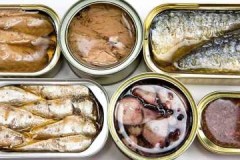Tips and tricks on how to properly store salted fish at home
 Fish is a perishable product. It should not be stored for too long.
Fish is a perishable product. It should not be stored for too long.
Both general and special requirements are imposed on its storage. The same goes for salted fish.
Separate nuances are provided for storing lightly salted and red salted fish. In some cases, you can slightly extend the shelf life of the product.
We will tell you further about how and where to properly store salted fish.
Content
General rules
The product should only be kept in dark places. Fish fillets should not be exposed to sunlight. The product should only be stored in a cool place with a stable temperature.
Salted fish fillets can be stored both in and out of the refrigerator. It is important to consider that in the first case the shelf life will be significantly longer than in the second.
If salted fish is stored outside the refrigerator, it must be wrapped in cloth. This product must be kept only in a dark, dry and cool place where the temperature does not exceed +12 0C.
Where is the product allowed to be kept?
 You can keep the product at home in a darkened cabinet. In private homes, a basement or cellar is best suited for this.
You can keep the product at home in a darkened cabinet. In private homes, a basement or cellar is best suited for this.
Salted fish fillets can be stored in a vacuum.If the packaging is not opened, the product can be kept in an apartment in a dark closet. But after opening the package, the salted fish should be placed in the refrigerator and consumed within 24 hours.
The fillets can be wrapped in wax paper and placed in a dark, cool place.. It is recommended to place white fish in a glass jar and fill it with brine. Under a tight lid, it can be kept in a dark closet away from sunlight.
After salting, fish fillets can also be wrapped in cotton cloth, which must first be moistened with vinegar. Then you need to put it in the darkest place in the closet.
Is it possible in foil?
The product can be kept in foil. It preserves its taste properties well and protects it from foreign odors. Foil also slightly extends the shelf life of fish fillets if they are stored outside the refrigerator in a dark, cool place in a closet or basement. It is recommended to wrap the product in two or three layers of foil.
How to keep it in the refrigerator longer?
Fish fillets can be stored both in the main compartment of the refrigerator and in the freezer. If salted fish is to be placed in the refrigerator, it must first be wrapped in cotton cloth soaked in vinegar. It can also be additionally wrapped in a plastic bag.
It is recommended to store salted fillets in the freezer. In this case, it must either be wrapped in foil or kept in vacuum packaging. Also can be placed in the freezer in a plastic container or bag.
Is it possible and how to store salted fish in the freezer? The video will tell you:
Features for lightly salted
Lightly salted fish fillets have an even more limited shelf life.. It is recommended to keep it only in a refrigeration device and only at a certain temperature.
At the same time, you should not freeze the fillet too much, since with subsequent thawing it will greatly lose its taste. It is better to store lightly salted product in a vacuum. This way it will be suitable for consumption for several months.
Nuances for red
 This type of fish, unlike white fish, tolerates freezing well. It can also be frozen at a temperature of -18 0C, but not lower.
This type of fish, unlike white fish, tolerates freezing well. It can also be frozen at a temperature of -18 0C, but not lower.
Before freezing, the fillet should be divided into pieces, each of which should be thoroughly wiped with napkins. There should be no moisture left on the carcasses.
Fish pieces must be wrapped in cling film, and then placed in zip bags, from which the air must first be pumped out.
Pieces of fish fillet in a tightly sealed bag can be stored in the freezer for up to six months.
But it is not recommended to keep them there for that long. They lose their taste and structure over time. It is better to freeze for a couple of months, during which the product is completely consumed.
It is important to defrost trout and salmon correctly. Defrosting must take place in several stages. First, the fillet is laid out from the freezer into the main compartment of the refrigerator, where it should lie for about 4 hours.Only after this can it be removed from the refrigerator and allowed to finally thaw at room temperature.
How long can a salted carcass be stored?
Storage temperature, availability and type of packaging, as well as the type of fish play a role. The following periods within which it can be stored are possible:
- At a temperature not exceeding 12 0C in a cloth soaked in vinegar or brine in a dark place - maximum 3 days.
- Lightly salted without vacuum in foil in the general refrigerator compartment - maximum 5 days.
- Salted fish fillets without vacuum in foil or a cloth soaked in vinegar in the refrigerator, but not in the freezer - maximum one week.
- In a vacuum in the refrigerator at 2-6 0C - up to one month.
- In brine and in the main refrigerator compartment at a temperature of 2-6 0C - up to one month.
- In the freezer at -4 0C and not lower than -8 0C – 20 days without vacuum packaging and 60 days if in vacuum.
- In the freezer from -4 0C to -8 0C in polymer jars 30 days, in glass - 45 days, in polymer barrels - 90 days.
How to extend the shelf life?
 The best way to extend the shelf life of a product is to place it in the refrigerator.
The best way to extend the shelf life of a product is to place it in the refrigerator.
Wherein It is recommended to freeze to a temperature of -8 0C. Deep freezing to -18 0C further extends the shelf life of the product. With this mode, fish fillets can last up to six months.
You can briefly extend the storage time of salted fish by rubbing it with vegetable oil. It is also recommended to completely submerge the fillets in the oil. It slows down the spoilage of the product and extends its shelf life for another week, provided it is stored in the refrigerator at 2-6 0C.
Placing it in brine further extends the shelf life of fish fillets. The higher the salt concentration in it, the longer it will be stored. It is better to keep the fish in brine, which is poured into a glass jar. It can be put in the refrigerator and kept there for 30 days.
It is important to consider the following conditions that affect storage duration:
- Before storage, the fillet must be cleaned of both scales and skin;
- the container itself in which the product is stored must be covered on top with a cloth soaked in vinegar or a salt-based solution;
- It is important to place fish fillets only in zip bags with evacuated air, which will prevent rapid oxidation and spoilage.
Bay leaves have the same disinfecting and preservative effect. You can also use peppercorns. Just sprinkle it on the salted fish, wrap it in foil and put it in the refrigerator on the top compartment.
Conclusion
It is recommended to store salted fish in the refrigerator. The best place for this is the freezer.. There it can remain for several months at temperatures down to -8 0C. Fish fillets are stored the longest at a temperature of -18 0C.
Vacuum packaging, brine and vegetable oil significantly extend the storage time. Salted fish can also be stored outside the refrigerator, but its shelf life will be greatly limited.
It is important to keep the product away from sunlight at all times and only in a cool place where the temperature is no more than 12 0C.


